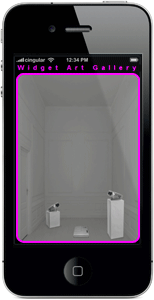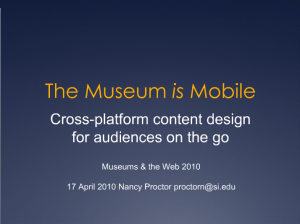I’ve been trying to find time to read Martin Reisers excellent book “The Mobile Audience” and hope to be able to post a full review of the book later this spring. One chapter in the book by Jon Dovey and Constance Fleuriot is however so practically useful that I wanted to devote a separate post to it. The chapter is called “Towards a Language fo Mobile Media”.
What Dovey and Fleuriot do in the chapter is develop what they call “descriptive dimensions of mobile media design”. The list is an immensely useful checklist for anyone planning on creating any kind of interactive mobile media art with an emphasis on location and mixed realities.
I have tried to recreate the list in a compact form below, for a more complete reading, please refer to the book!
Dimension |
From |
To |
Explanation |
| Immersion | |||
| Information | Evocation | Does the experience inform or evoke emotions? | |
| User control | |||
| None | Total | Does the user control navigation through the experience? | |
| Clear rules | Unclear rules | Does the user control navigation through the experience? | |
| Space/place mapping | |||
| Arbitrary | Meaningful | Is content related to the user’s physical surroundings or disconnected from it? | |
| Space | |||
| Linearity | Non linearity | Can the user explore the experience or only move along a predefined path? | |
| Time | |||
| Fixed running | Open running | Does the experience have an internal timeline? | |
| Specific | Unspecific | Is the experience bound to a certain time (time of day, season, time of year)? | |
| Permanent | One-off | How long will the experience be available to visitors? | |
| Depth of data | |||
| One level | Several levels | Are there several layers of data, eg like “worlds” in games or is everything accessible at once? | |
| Social | |||
| Private | Public | Is the experience personal or is it open to be seen by a wider audience? | |
| Solitary | Collaborative | Do users see the same or separate media, can they interact in relation to the same media? | |
| Producer expertise | |||
| Professional | Amateur | Does content appear “produced” or does it look authentic as if created by “real people”? | |
| Relation to environment | |||
| Augmentation | New experience | Is the experience bound to the location or new and separate? | |
Once you have been able to decide on all the above aspects of any immersive/locative media work that you might be planning, you already have a very good idea of what it it that you are going to produce.




 I had the good fortune to spend a highly interesting week in Tokyo, touring a number of high-tech companies together with a group of PhD students from the Aalto University.
I had the good fortune to spend a highly interesting week in Tokyo, touring a number of high-tech companies together with a group of PhD students from the Aalto University. The 3 Inch Canvas is by no means a music site and we do not pretend to have any competences in the area of anything audible. However, there are some really cool dudes over at the
The 3 Inch Canvas is by no means a music site and we do not pretend to have any competences in the area of anything audible. However, there are some really cool dudes over at the 

